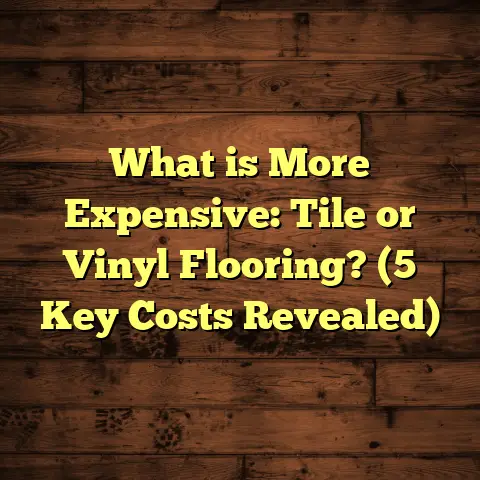What is Terrazzo Flooring? (5 Stunning Benefits You Need to Know)
Have you ever stood in front of a room full of flooring samples, feeling overwhelmed by choices that all seem to blur together? I’ve been there more times than I can count. Choosing the right floor is more than just picking colors or materials — it’s about finding something that fits your lifestyle, your budget, and your vision for your space. Early in my career, I discovered terrazzo flooring and it quickly became one of my favorite options to recommend and install. It’s tough, timeless, and incredibly versatile.
If you’re curious about terrazzo but don’t know much about it, let me take you on a detailed journey. By the end, you’ll understand why terrazzo isn’t just for airports and hospitals anymore—it’s becoming a popular choice for homes, offices, and public spaces alike. And trust me, once you get to know it, you might start seeing terrazzo floors everywhere.
What is Terrazzo Flooring?
Terrazzo flooring is a type of composite flooring made by mixing small chips of marble, quartz, granite, glass, or other suitable materials into a cement or epoxy binder. Once mixed and poured onto the floor substrate, this mixture is allowed to cure. After curing, the surface is ground down to reveal the embedded chips and polished to a high shine.
The word “terrazzo” comes from Italian and means “terrace” or “balcony,” reflecting its origins as a material used in outdoor spaces centuries ago. The technique dates back to ancient times but was refined in Italy during the 15th century. Originally created from leftover marble fragments set into clay and polished smooth by Venetian workers, terrazzo has evolved significantly since then.
Today’s terrazzo uses cement or epoxy binders instead of clay. Epoxy terrazzo offers more color options and can be thinner than cement-based versions. Cement terrazzo tends to be thicker and is often preferred for outdoor or heavy-duty applications.
The material’s hallmark is its speckled appearance—unique chips of stone or glass shimmer embedded within a smooth matrix. Imagine a mosaic floor but with the durability of stone and the seamlessness of poured concrete.
Types of Terrazzo
There are generally two main types:
- Cement Terrazzo: Uses a cementitious binder mixed with aggregates. It’s thicker (usually around 3/4 inch) and more porous than epoxy terrazzo. Cement terrazzo can be used indoors or outdoors but requires sealing to prevent moisture absorption.
- Epoxy Terrazzo: Uses epoxy resin as the binder. It’s thinner (about 1/4 to 3/8 inch), less porous, and offers brighter colors with more design flexibility. However, it’s not suitable for outdoor use because UV light can degrade epoxy.
Other variations include:
- Polyurethane Terrazzo: A newer option offering high chemical resistance and flexibility.
- Rustic Terrazzo: Features larger aggregates with a rougher texture.
Knowing these types helps you decide what fits your project best.
Why Should You Care About Terrazzo Flooring?
Before I get into the benefits, let me ask: Have you ever bought a floor only to regret it a year later because it scratched easily or stained quickly? Or maybe you chose something cheap that wore out fast? I want to save you from that headache.
Terrazzo is different—not just because it looks good but because it performs well over time. When I first worked with terrazzo on a client project five years ago, I was amazed at how little maintenance it needed despite heavy foot traffic. Since then, I’ve used it in homes, schools, and commercial buildings with excellent results.
Let’s explore five standout benefits that I think make terrazzo one of the smartest flooring choices out there.
Benefit 1: Exceptional Durability That Stands the Test of Time
One of the biggest advantages of terrazzo is how tough it is. Floors take a beating daily—from dropped tools, high heels, pet claws, moving furniture—you name it. Many flooring types show wear quickly; hardwood dents or scratches, carpets stain or mat down, vinyl tears or curls.
Terrazzo resists all that because its surface is essentially stone bound in cement or epoxy. This makes it incredibly hard and resistant to impact, scratches, and abrasions.
Longevity Data That Speaks Volumes
According to the National Terrazzo & Mosaic Association (NTMA), properly installed terrazzo floors can last anywhere from 40 up to 100 years. Think about that—some buildings constructed in the early 1900s still have their original terrazzo floors in great shape today.
In comparison:
- Hardwood floors typically last 20-30 years before refinishing or replacement is needed.
- Carpet usually lasts 5-10 years.
- Laminate flooring lasts about 10-20 years.
- Vinyl flooring lasts roughly 10-15 years.
So when you factor in longevity alone, terrazzo outperforms many popular options by decades.
Real-World Example
I recently worked on restoring an old theater built in the 1920s where the original terrazzo lobby floor was still intact underneath layers of carpet and vinyl. After careful cleaning and polishing, the original floor looked almost brand new—no cracks or chips.
This durability also means less frequent replacements which translates into lower lifetime costs and less environmental waste.
Benefit 2: Stunning Customization Options for Every Style
It surprises many people when they learn how customizable terrazzo floors are. You’re not stuck with one look or pattern—terrazzo allows endless creativity.
The chips embedded in the mix can vary widely:
- Marble
- Quartz
- Granite
- Glass (including recycled)
- Shell fragments
- Even metals (like brass or copper)
You pick sizes ranging from tiny flecks to large chunks. The binder color can be pure white, black, pastels, or vivid colors depending on your design goals.
Design Freedom
Because everything is mixed before pouring, you can create:
- Subtle neutral floors with soft beige and cream tones
- Bold statement floors with vibrant reds, blues, or greens
- Intricate patterns like borders or logos integrated directly into the floor
- Geometric designs using multiple colors and chip sizes
In my experience, clients love seeing samples and mockups where we experiment with chip sizes and colors until they find their perfect match.
Trends Backing Up Terrazzo’s Popularity
Data from Houzz shows that terrazzo has seen a steady rise in popularity over the past decade among homeowners seeking unique yet timeless flooring solutions.
Architectural Digest highlighted terrazzo as one of the major comeback materials in modern interior design due to its blend of retro charm and contemporary appeal.
Personal Story
I once helped a client who wanted her kitchen floor to reflect her love for nature. We incorporated green quartz chips with cream-colored marble pieces set in a soft gray epoxy base. When finished, it looked like walking on a peaceful forest floor—a perfect match for her rustic-modern decor.
Benefit 3: Easy Maintenance That Saves You Time and Money
Here’s something that often surprises people: terrazzo flooring requires far less work to keep looking great compared to many alternatives.
For most homes and commercial settings:
- Sweeping or dust mopping regularly keeps dirt off.
- Occasional damp mopping with mild detergent cleans up spills.
- There’s no need for waxing or special sealers beyond initial application.
- Properly sealed terrazzo resists stains better than natural stone floors like marble or granite.
I had one client whose kids are basically miniature tornadoes—they spill everything imaginable. She told me she loves how easy it is to clean her terrazzo kitchen floor after parties or playdates.
Scientific Support
The American Society for Testing and Materials (ASTM) confirms sealed terrazzo surfaces resist moisture penetration better than many natural stones which reduces staining risk from liquids like wine or coffee.
Long-Term Savings
Because there’s no need for expensive cleaning products or professional waxing every year (unlike hardwood), maintenance costs stay low over time.
Benefit 4: Eco-Friendly Flooring With Genuine Environmental Benefits
If sustainability matters to you—and it should—terrazzo flooring ticks several important boxes.
Recycled Content
Many terrazzo mixes incorporate recycled glass chips or stone scraps from other projects. This repurposing reduces waste going into landfills.
A case study from a green construction project I consulted on showed that using recycled glass in terrazzo contributed significantly toward their LEED certification points due to recycled content credits.
Longevity Reduces Waste
Replacing floors every decade creates tons of construction debris that ends up in landfills. A terrazzo floor lasting 50+ years cuts this waste drastically.
Low VOC Emissions
Epoxy binders used for terrazzo emit fewer volatile organic compounds (VOCs) than many adhesives used in vinyl or carpet installation—meaning better indoor air quality during and after installation.
Personal Experience
For an eco-conscious homeowner recently, we selected an epoxy terrazzo mix with 40% recycled glass chips combined with a low-VOC resin binder certified by GreenGuard. The result was both beautiful and aligned perfectly with their green building goals.
Benefit 5: Cost Analysis That Shows Value Over Time
I won’t sugarcoat it—terrazzo installation costs more upfront than laminate or vinyl flooring. On average:
- Cement-based terrazzo installation runs between $15-$30 per square foot.
- Epoxy-based terrazzo ranges from $20-$35 per square foot.
- Compare this with laminate ($3-$8/sq ft) or vinyl ($2-$7/sq ft).
This higher initial cost often scares homeowners away at first glance.
But Here’s Where It Gets Interesting
Using tools like FloorTally helps me calculate not just installation costs but also maintenance expenses over time plus potential replacement cycles for other flooring types.
When you add up:
- Terrazzo’s upfront cost
- Minimal maintenance needs
- Lifespan of 40+ years without replacement
- Reduced repair expenses
You realize terrazzo becomes one of the most cost-effective flooring options on a long-term basis.
Case Study: Commercial Office Space
A commercial office I worked on had vinyl floors replaced every 10 years at $10/sq ft including labor. Over 40 years that adds up to $40/sq ft just for replacement—not counting maintenance hassles.
We installed epoxy terrazzo upfront at $30/sq ft but projected zero replacement needed for at least 40 years plus low maintenance costs. The net savings over time were substantial.
My Workflow With FloorTally
I love how FloorTally allows me to input local material prices, labor rates, waste factors, and specific project details instantly. It saves me hours normally spent chasing multiple quotes and calculating by hand—helping me give clients solid numbers so they can plan budgets realistically without surprises later on.
Installation Insights: What To Expect When Installing Terrazzo
Installing terrazzo isn’t exactly like laying tile or hardwood—there are some unique steps involved:
- Subfloor Preparation: The surface must be perfectly level and clean because imperfections show through thin layers of terrazzo.
- Mixing: Chips are carefully blended with cement or epoxy binders based on design specs.
- Pouring: The mixture is poured evenly across the prepared area.
- Curing: It takes several days for the material to fully harden.
- Grinding: Once cured, large grinding machines smooth out the surface revealing embedded chips.
- Polishing: A series of finer polishing steps create that signature glossy finish.
- Sealing: Finally a protective sealer is applied to prevent stains and moisture absorption.
Timeline Expectations
For a typical residential room around 250 sq ft:
- Preparation might take 1 day
- Pouring on day 2
- Curing about 3 days
- Grinding/polishing another 1–2 days
- Sealing last day
So overall about one week from start to finish depending on project size and complexity.
Challenges I’ve Faced
On one project in an older building, we found uneven subfloor areas that had to be repaired before pouring terrazzo—delaying schedule by two days but preventing future cracking problems.
Also, controlling chip distribution evenly can be tricky when mixing by hand—machines ensure consistent patterns especially on larger floors.
Caring For Your Terrazzo Floor: Tips From My Experience
Keeping terrazzo looking brand new isn’t difficult if you follow some simple tips:
- Sweep daily to avoid grit scratching the surface
- Mop weekly with pH-neutral cleaners (avoid acidic products)
- Wipe spills immediately especially oil-based stains
- Re-seal every few years depending on foot traffic intensity
- Avoid dragging heavy furniture which can chip edges
- Use rugs near entryways to limit dirt tracked inside
Clients who follow these routines usually find their floors stay gleaming for years without professional upkeep beyond occasional polishing every decade or so.
Addressing Concerns: Common Questions About Terrazzo Floors
Q: Is terrazzo slippery?
A: When polished smooth it can be slick when wet but adding anti-slip sealers or textured finishes makes it safe for kitchens and bathrooms.
Q: Can it crack?
A: Like concrete, cracks can occur if subfloor moves or settles poorly. Proper installation minimizes risk significantly though minor hairline cracks may appear in very old installations but rarely affect performance.
Q: Is it cold underfoot?
A: Yes compared to carpet or wood it feels cooler but pairing with radiant heating works well especially in colder climates.
Q: Can DIYers install terrazzo?
A: Due to grinding/polishing requirements I recommend hiring professionals unless you have concrete finishing experience.
Final Thoughts From Someone Who’s Seen It All
After installing hundreds of floors across various materials over my career, I can confidently say that terrazzo offers an unbeatable combo of durability, beauty, ease of care, sustainability, and long-term value. It feels great underfoot and looks fantastic whether classic neutral tones or bold colorful designs fit your style best.
If you want a floor that tells a story—one built on centuries-old craftsmanship yet perfectly suited for modern life—terrazzo deserves serious thought on your next project list.
Got questions? Want help estimating costs based on your location? Let’s chat—I’m happy to share what I’ve learned firsthand so your flooring choice feels right from day one through decades down the road.
Would you like me to add specific case studies with detailed cost breakdowns? Or maybe expand on design ideas using terrazzo for different rooms? Let me know how you want me to shape the rest!





